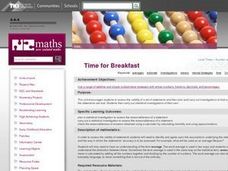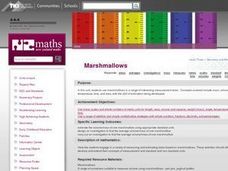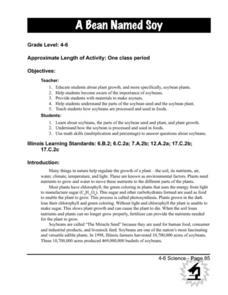Curated OER
Create A Question
Students explore mathematical problem solving. Given a case problem, students write a rule to solve problems involving decimal multiplication and division. They invent problems, share them with the class, and solve other student's...
Curated OER
My Dogs
Learners use the properties of multiplication to solve problems. They recall the basic multiplication facts as well as write and solve problems that involve whole numbers.
Curated OER
Squirt
Fourth graders using the idea of "how many more squirts" fill a container to develop multiplicative thinking. They also investigate the idea of conservation of volume when working with oddly shaped containers. They attempt to use...
Curated OER
Ohio Census 1990 and 2000
Students begin the lesson by examining Census data from the state of Ohio from 1990 and 2000. Using a worksheet, they solve problems using the data and a calculator. They share their responses with the class and discuss what the data...
Curated OER
Lollies, Lollies, Lollies
Students listen to the problem read to them. They answer some simple questions using number sentences. They then compose a written record of the solution and share their approaches used.
Curated OER
Time For Breakfast
This unit encourages students to assess the validity of a set of statements and then plan and carry out investigations to find out whether the statements are true. Students then carry out statistical investigations of their own.
Curated OER
Marshmallows
Third graders estimate the volume and mass of one marshmallow using appropriate standard units. They design and carry out an investigation to find the average of volume/mass of one marshmallow.
Curated OER
The Fathers' Day Card
Students subtract using decimals and find half of a decimal number. They write and solve problems which involve decimals and which require a choice of one or more of the four arithmetic operations.
Curated OER
Time Problems
Young scholars make sensible estimates and check for reasonable results. They also solve problems with positive and negative integers using practical activities or models as needed.
Curated OER
The Difference Bar 2
Young scholars use Internet software, The Difference Bar, to work out the difference between two numbers by breaking numbers into parts. Students use mental strategies to work out the difference between any 2 two-digit numbers. Young...
Curated OER
Term Deposits: Worth the Wait?
Students study term deposits and the attributes of long and short-term savings. They examine their spending habits while looking at how different types of accounts meet different economic goals. They complete worksheets that are provided...
Curated OER
The Clumsy Tiler N (Fractions)
Students explore patterns and geometric sequencing. Students devise and use problem solving strategies to explore situations mathematically. Students solve real life problems. They demonstrate, with cardboard pieces, fraction and...
Curated OER
Take Away Bar 2
Students use an Internet tool, The Take-Away Bar" to solve subtraction problems. They use mental strategies to subtract a two-digit number from a larger two-digit number. Students write and solve subtraction problems. They describe...
Curated OER
Soybeans: The Miracle Seed
Students discover why soybeans are called the "miracle seeds." They make their own soynuts and share other foods made from soybeans. They create a bulletin board of soybean products.
Curated OER
Washing Air
Students observe a model of a wet scrubber. They discuss this and other methods of pollutant recovery. They discover how engineers use this information to protect the environment.
Curated OER
Cave Mentality
Learners identify and define vocabulary associated with caves and rock formations. They construct a cave out of paper and fill it with a geode they crerate. Students write and present orally reports about caves and their importance to...
Homeschool Math
Homeschool Math: How to Calculate Percentages
Learn how to calculate percentages in this easy lesson.
Scholastic
Scholastic: Baseball Math
Learn more about baseball and math when you check out this resource. It provides a lesson plan for upper elementary to middle school students where they will use their skills in percentages, decimals and combinations.
BBC
Bbc Skillswise: Percent and Fractions: Ratio and Proportion
Activities and factsheets exploring ratios and proportions in everyday life. Interactive, colorful, and fun.


















